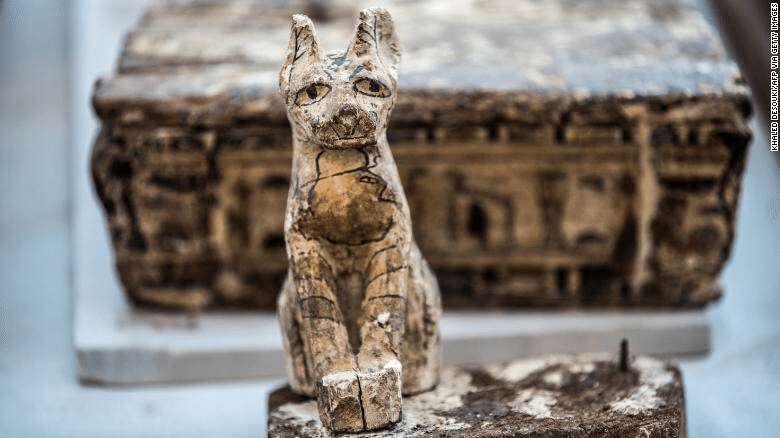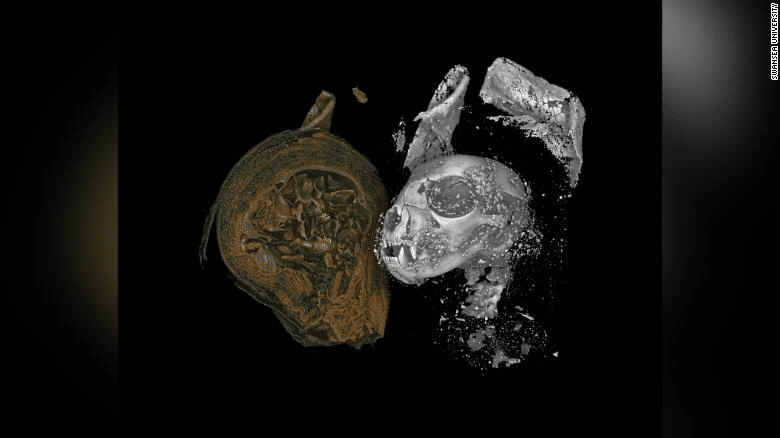
Scientists have 'digitally unwrapped' some Egyptian animal mummies, including a kitten and cobra ≒ 科学者たちは、子猫やコブラなどのエジプトの動物のミイラを「デジタルラップ解除」しました
Scientists have 'digitally unwrapped' some Egyptian animal mummies, including a kitten and cobra
https://www.cnn.com/2020/08/21/world/mummies-digitally-unwrapped-scli-intl-gbr-scn/index.html
By Jack Guy, CNN
Updated 12:05 PM EDT, Fri August 21, 2020
London(CNN)Researchers at a UK university have "digitally unwrapped" three mummified animals from ancient Egypt using high-resolution 3D scans.
The team were also able to dissect the mummies to learn how the animals lived and died more than 2,000 years ago, according to a press release from the University of Swansea in Wales, published Thursday.
Previous research had shown that the mummies contained a snake, a bird and a cat, but now X-ray micro CT scanning -- which gives images 100 times more detailed than a medical CT scan -- means scientists have even been able to look at the animals' teeth.

Images revealed details about the cat's life and death.
Images revealed details about the cat's life and death.
"Using micro CT we can effectively carry out a post-mortem on these animals, more than 2000 years after they died in ancient Egypt," said Richard Johnston, a professor at Swansea University, who led the research.
"These are the very latest scientific imaging techniques. Our work shows how the hi-tech tools of today can shed new light on the distant past."
Researchers found the cat was less than five months old, and separation of its vertebrae suggest it was strangled to death, while the bird was identified as a Eurasian kestrel, thanks to virtual bone measurement.

The cobra was mummified coiled up.
The snake was a juvenile Egyptian cobra, and scientists found evidence of kidney damage, which means it probably suffered from a lack of access to water and developed a form of gout.
Researchers say the cobra was killed by a "whipping action" and may have been subject to the "opening of the mouth" ceremony during mummification.
This ceremony, which doesn't necessarily involve physically opening the mouth, was carried out on human mummies and statues of gods, and there is some evidence of it being done to mummified animals.
"The idea of it is that you make something, by carrying out the ritual, divine," said Carolyn Graves-Brown, curator of the Egypt Centre at Swansea University. "You make it be able to act in the real world."
Graves-Brown believes that small balls found in the cobra's mouth may mean it was subject to the ceremony, and if it were it would be the first evidence of complex ritualistic behavior applied to a snake.

Scans revealed one of the mummies was a Eurasian kestrel.
Mummified animals such as cats, snakes, crocodiles and dogs were common in ancient Egypt. Sometimes they were buried with their owner, or provided as a source of food in the afterlife.

Related Article:Egypt hails rare find of mummified lion cubs, cats and crocodiles
However, most often mummified animals were taken to temples as an offering to the gods.
"Millions and millions of mummified animals have been found, so much so that in the past, in the Victorian times, they used to use them as compost to put on the land," said Graves-Brown.
Some big museums have collections of millions of mummies, and it's unlikely they would carry out this kind of scanning on a large scale, because of the amount of work involved in scanning and analyzing the resulting data.
However, the technology could open many new avenues of research -- for example, revisiting mummified bird samples to determine the exact species, the researchers said.

Related Article: Egypt discovers a tomb full of mummified cats, mice and other animals
In November 2019, Egypt unveiled an unprecedented discovery of dozens of mummified sacred animals, including cats, crocodiles and two lion cubs, found during the excavation of a tomb of a royal priest.
Khaled El-Enany, Egypt's minister of antiquities, said the find dated back to the seventh century BC and could fill "a museum by itself."
And in April 2019 the ministry announced the discovery of a preserved double graveyard containing the remains of a man, his wife, and mummified animals, including cats and mice.
科学者たちは、子猫やコブラなどのエジプトの動物のミイラを「デジタルラップ解除」しました
ジャック・ガイ、CNN
2020年8月21日金曜日、東部夏時間12:05に更新
英国の大学のロンドン(CNN)の研究者たちは、高解像度の3Dスキャンを使用して、古代エジプトからミイラ化した3匹の動物を「デジタルでアンラップ」した
木曜日に発表されたウェールズのスウォンジー大学のプレスリリースによると、チームはミイラを解剖して2000年以上前に動物がどのように生きて死んだかを知ることができた。
以前の研究では、ミイラにはヘビ、鳥、猫が含まれていることが示されていましたが、現在では医療用CTスキャンよりも100倍詳細な画像が得られるX線マイクロCTスキャンにより、科学者は 動物の歯。

画像は猫の生死の詳細を明らかにした。
研究を主導したスウォンジー大学のリチャードジョンストン教授は、次のように述べています。
「これらは最新の科学的画像技術です。私たちの仕事は、今日のハイテクツールが遠い過去に新しい光をどのように当てることができるかを示しています。」
研究者たちは、猫が生後5か月未満であることを発見し、その脊椎の分離は、死ぬまで絞め殺されたことを示唆している一方で、鳥は、仮想骨測定のおかげでユーラシアのチョウゲンボウと識別されました。

コブラはコイル状にミイラ化されました。
ヘビは幼いエジプトのコブラでした、そして科学者は腎臓の損傷の証拠を発見しました、それはそれがおそらく水へのアクセスの欠如に苦しんでそして痛風の形を発達させたことを意味します。
研究者は、コブラは「鞭打ち行動」によって殺され、ミイラ化の間に「口を開ける」式典の対象となった可能性があると言います。
この式典は必ずしも肉体的に口を開ける必要はありませんが、人間のミイラと神々の像について行われたもので、ミイラ化した動物に対して行われたという証拠があります。
スウォンジー大学エジプトセンターのキュレーターであるキャロリングレイブスブラウンは、次のように語っています。 「現実の世界で行動できるようにします。」
グレイブスブラウンは、コブラの口にある小さなボールが儀式の対象となった可能性があると考えており、それがヘビに適用された複雑な儀式的な行動の最初の証拠であると考えています。

スキャンの結果、ミイラの1人がユーラシアのチョウゲンボウであることが判明しました。
猫、ヘビ、ワニ、犬などのミイラ化した動物は古代エジプトでは一般的でした。 時には彼らは飼い主と一緒に葬られたり、来世の食料源として提供されたりしました。

エジプト、ミイラ化したライオンの子、猫、ワニの珍しい発見を歓迎
しかし、ミイラ化した動物は神々への供物として寺院に連れて行かれました。
「数百万のミイラ化された動物が発見されたため、ビクトリア時代には過去に堆肥として使用して土地に置くことが多かった」とグレイブスブラウン氏は語った。
いくつかの大きな美術館には数百万のミイラのコレクションがあり、結果のデータのスキャンと分析に必要な作業量が多いため、この種のスキャンを大規模に実行することはほとんどありません。
しかし、この技術は多くの新しい研究の道を開く可能性がある。たとえば、ミイラ化された鳥のサンプルを再検討して正確な種を特定する、などと研究者たちは述べた。

エジプトはミイラ化した猫、マウスおよび他の動物でいっぱいの墓を発見します
2019年11月、エジプトは、猫、ワニ、2頭のライオンの子など、ミイラ化した数十の神聖な動物が王室の墓の発掘中に発見された前例のない発見を発表しました。
エジプトの古代美術大臣であるハレドエルエナニーは、この発見は紀元前7世紀にさかのぼり、「博物館自体」を埋めることができると述べました。そして、2019年4月に同省は、男性と彼の妻の遺体、および猫やマウスを含むミイラ化した動物の遺跡を含む保存された二重墓地の発見を発表しました。
この記事が気に入ったらサポートをしてみませんか?
